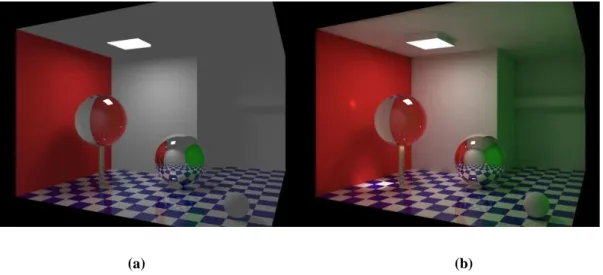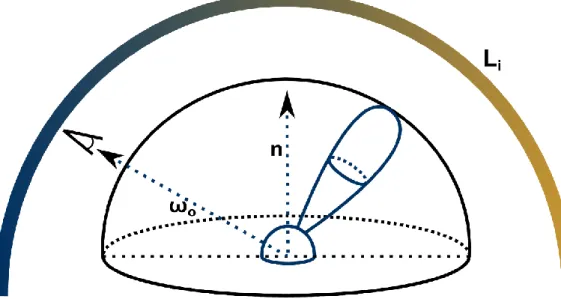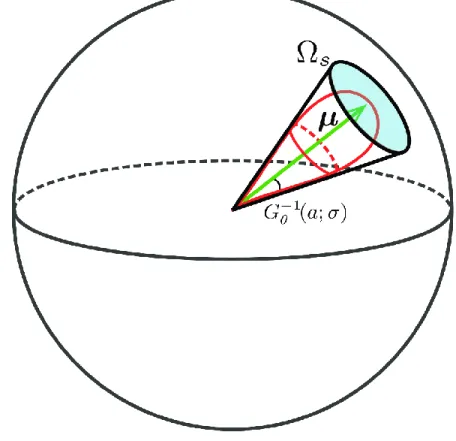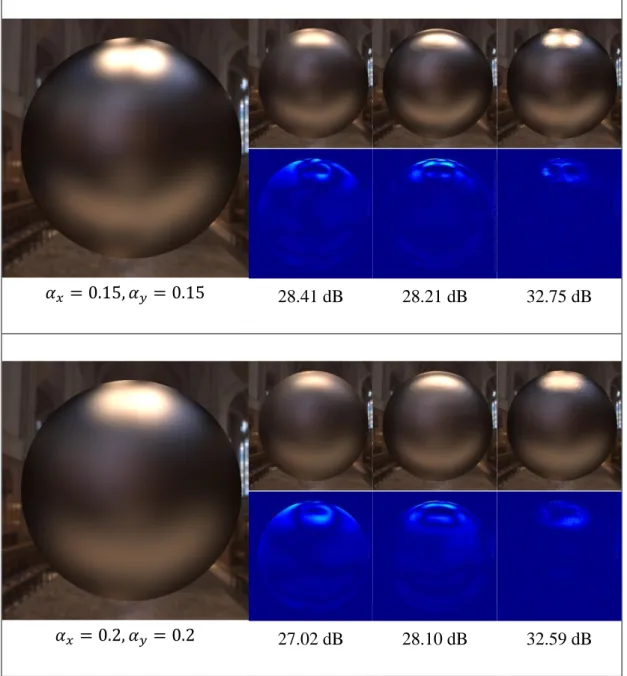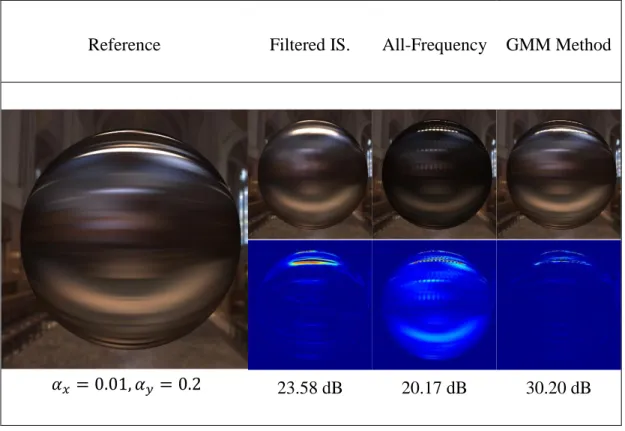YAŞAR UNIVERSITY
GRADUATE SCHOOL OF NATURAL AND APPLIED SCIENCES MASTER THESIS
REAL-TIME RENDERING ON MOBILE GRAPHICS
USING GAUSSIAN MIXTURE MODELS
Özkan Anıl TÖRAL
Thesis Advisor: Prof. Dr. M. Cudi OKUR
Department of Computer Engineering
Presentation Date: 19.06.2015
Bornova-İZMİR 2015
ii
I certify that I have read this thesis and that in my opinion it is fully adequate, in scope and in quality, as a dissertation for the degree of master of science.
Prof. Dr. M. Cudi OKUR (Supervisor)
I certify that I have read this thesis and that in my opinion it is fully adequate, in scope and in quality, as a dissertation for the degree of master of science.
Assist. Prof. Cengiz GÜNGÖR I certify that I have read this thesis and that in my opinion it is fully adequate, in scope and in quality, as a dissertation for the degree of master of science.
Assist. Prof. Korhan KARABULUT
--- Prof. Dr. Behzat GÜRKAN Director of the Graduate School
iii ABSTRACT
REAL-TIME RENDERING ON MOBILE GRAPHICS USING GAUSSIAN MIXTURE MODELS
TÖRAL, Özkan Anıl MSc in Computer Engineering Supervisor: Prof. Dr. M. Cudi OKUR
June 2015, 33 pages
In this thesis, we developed a real-time global illumination application for mobile devices and we show that, real-time rendering technique using Gaussian Mixture Model (GMM) for environment lighting is possible even with a low-power mobile graphics processing unit (GPU). With our implementation, isotropic and anisotropic materials can be visualized in real-time by changing the parameters of Bidirectional Reflectance Distribution Function (BRDF). We extend our GMM method to mobile graphics. Our GMM technique represents isotropic and anisotropic BRDFs using sum of Spherical Gaussians (SG) fitted by Expectation Maximization (EM) algorithm, which provide an accurate approximation with acceptable number of lobes. To suppress the approximation errors, we use GPU generated MIP-maps for filtering environment maps. MIP-mapped lookup is calculated by the size of SG lobes to make filtering more efficiently. Based on the results, it is shown that both isotropic and anisotropic reflectances can be handled in real-time on mobile phones using our GMM technique.
Keywords: Mobile Graphics, Gaussian Mixture Models, Computer Graphics, Real-time Rendering, Precomputed Radiance Transfer, Spherical Gaussian.
iv ÖZET
MOBİL GRAFİKLER İÇİN GAUSSIAN KARIŞIM MODELİ KULLANARAK GERÇEK ZAMANLI GÖRÜNTÜLEME
Özkan Anıl TÖRAL
Yüksek Lisans, Bilgisayar Mühendisliği Bölümü Tez Danışmanı: Prof. Dr. M. Cudi OKUR
Haziran 2015, 33 sayfa
Bu tezde, mobil cihazlar için gerçek-zamanlı çevresel ışıklandırma uygulaması geliştirdik ve Gaussian Karışım Modeli (Gaussian Mixture Model, GMM) kullanarak çevresel ışıklandırmanın düşük-güçlü mobil grafik işlemci ünitelerinde (Graphics Processing Unit, GPU) de mümkün olabileceğini gösterdik. Uygulamamızda çift-yönlü yansıma dağılım fonksiyonlarının (Bidirectional Reflectance Distribution Function, BRDF) parametreleri değiştirilerek istenilen yönbağımlı ve yönbağımsız materyallerin gerçek-zamanlı olarak görüntülenmesi sağlanmıştır. GMM yöntemimizi mobil grafikler için uygun olacak şekilde de genişlettik. GMM yöntemimiz yönbağımlı ve yönbağımsız BRDF’leri, beklenti maksimizasyonu (Expectation Maximization, EM) kullanılarak yerleştirilmiş küresel Gaussian (Spherical Gaussians, SG) ile ifade ederek, gerekli SG sayısını kabul edilebilir bir sayıya indirir. Tahminlemeden kaynaklanan hataları azaltmak için, GPU tarafından oluşturulan MIP-mapleri kullanarak çevreyi filtreleriz. MIP-maplerin seviyeleri SG’lerin genişlikleri ile verimli bir şekilde hesaplarız. Sonuçlar doğrultusunda yönbağımlı ve yönbağımsız yansımaların gerçek-zamanlı olarak GMM yöntemimiz ile mobil cihazlar üzerinde de görüntülenebileceği gösterilmiştir.
Anahtar sözcükler: Mobil Grafikler, Gaussian Karışım Modelleri, Bilgisayar
v
ACKNOWLEDGEMENTS
I would like to thank to my supervisor Prof. Dr. M. Cudi OKUR for his patient guidance and encouragement on my thesis.
I would also like to thank Prof. Dr. Aydın ÖZTÜRK, Serkan ERGUN and Dr. Murat KURT for their contributions and for their comments.
Also I would like to thank to my fiancée Serap KIRTEPE, for all her love and support.
Özkan Anıl TÖRAL Ankara, 2015
vi
TEXT OF OATH
I declare and honestly confirm that my study, titled “REAL-TIME RENDERING ON MOBILE GRAPHICS USING GAUSSIAN MIXTURE MODELS” and presented as a Master’s Thesis, has been written without applying to any assistance inconsistent with scientific ethics and traditions, that all sources from which I have benefited are listed in the bibliography, and that I have benefited from these sources by means of making references.
vii TABLE OF CONTENTS Page ABSTRACT iii ÖZET iv ACKNOWLEDGEMENTS v TEXT OF OATH vi
TABLE OF CONTENTS vii
INDEX OF FIGURES ix
INDEX OF SYMBOLS AND ABBREVIATIONS x
1 INTRODUCTION 1
1.1 Subject of the Thesis 1
1.1 Related Work 2 2 BACKGROUND 4 2.1 Global Illumination 4 2.2 Rendering Equation 4 2.3 BRDF 5 2.4 Spherical Gaussians 5
viii
2.6 Real-time Rendering Using SGs 8
3 IMPLEMENTATION 11 3.1 Unity3D 11 3.2 Android SDK 11 3.3 Cg Programming 11 4 RESULTS 12 4.1 Method Comparison 12 4.2 Mobile Results 16 5 CONCLUSION 17 REFERENCES 18 CURRICULUM VITEA 22
ix
INDEX OF FIGURES
Figure 2.1 Scenes rendered without (a) and with (b) global illumination. 4
Figure 2.2 BRDF visualisation in a reflectance hemisphere. 5
Figure 2.3 Spherical Gaussian and the mean direction with solid angle. 8
Figure 4.1 Method comparison in Grace Cathedral scene. 14
Figure 4.2 Method comparison in Grace Cathedral scene for anisotropic materials.
15
Figure 4.3 Screenshots from mobile device with 8 SGs. 16
x
INDEX OF SYMBOLS AND ABBREVIATIONS
Symbols Explanations
𝐿𝑜 Total outgoing radiance 𝜔𝑜 Direction of the outgoing light 𝐿𝑖 Incoming radiance
𝜔𝑖 Incoming light direction 𝑛 Surface normal
𝜌(𝜔𝑖, 𝜔𝑜) BRDF 𝜇 Lobe axis 𝜅 Lobe sharpness Ω𝑠 Solid angle
xi Abbreviations
GMM Gaussian Mixture Model
BRDF Bidirectional Reflectance Distribution Function EM Expectation Maximization
SG Spherical Gaussians GPU Graphics Processing Unit PRT Precomputed Radiance Transfer SH Spherical Harmonics
SRBF Spherical Radial Basis Functions ASG Anisotropic Spherical Gaussians PSNR Peak Signal-to-Noise Ratio
1 1 INTRODUCTION
1.1 Subject of the Thesis
Visualization of materials in different lighting environments in real-time is an important subject in computer graphics. Extending this subject into mobile graphics is a major challenge because of low computing power and heating problems. In this thesis we focused on these subjects.
Approximation of the illumination integral can produce some errors. To reduce these errors, there are some noise reduction techniques such as multiple importance sampling (Veach, 1998) have been proposed. Convolving environmental maps as a pre-filtering step can be approached for eliminating numerical estimation. Since the isotropic BRDFs are radially symmetric, only the lobe direction and size can be used for filtering environment maps, but for the anisotropic materials the orientation of the lobe must also be taken into account. In this thesis we show that GMMs can also provide an accurate approximation for anisotropic BRDFs.
In real-time rendering, adopting SGs to represent spherical functions is a popular technique to estimate BRDFs in global illumination. Recent techniques (Tsai and Shih, 2006, Wang et al., 2009, Xu et al., 2013) used SGs to represent BRDF, lighting and visibility approximation.
In this thesis we use GMM fitted by EM algorithm to represent both isotropic and anisotropic BRDFs. We use hardware generated MIP-maps in real-time, which does not require pre-computation, to suppress the approximation errors. We also extend this technique to mobile graphics to work with a low-power mobile graphics processing unit (GPU).
Our technique is more efficient than its competitors with similar approaches like (Tsai and Shih, 2006, Wang et al., 2009, Xu et al., 2013, Iwasaki et al., 2012), in terms of computation time of fitting GMM, and the scene can be changed dynamically.
2
Ö. A. Töral, S. Ergun, M. Kurt, A. Öztürk, 2014, Mobile GPU-Based Importance Sampling Signal Processing and Communications Applications Conference (SIU), IEEE, 22nd, p. 510-513, Trabzon, Turkey.
Ö. A. Töral, S. Ergun, A. Öztürk, 2014, Real-Time Distant Light Filtering using Gaussian Mixture Model Proceedings of EURASIA GRAPHICS 2014, Hacettepe University Press, p. 1:1-1:6, Ankara, Turkey.
1.1 Related Work
There are many techniques for evaluating the Rendering Equation (Kajiya, 1986). A popular approach for the evaluation of the equation is to sampling the light (Szecsi et al., 2010, Ergun et al., 2012), or BRDF (Ward, 1992, Bilgili et al., 2011, Lawrence et al., 2004, Pacanowski et al., 2012). However, using one of these strategies can be inaccurate to approximate outgoing radiance in Rendering Equation.
Precomputed Radiance Transfer (PRT) (Sloan et al., 2002) supports low-frequency lighting environments only and requires using Spherical Harmonics (SH) for lighting. SHs (Ramamoorthi, 2001) solve the pre-filtering step but they can only work with low-frequency lighting and static BRDF. Haar wavelets (Ng et al., 2003) for PRT supports all-frequency lights, but it has high memory and precomputation costs. Factoring BRDF into separate view and light components works well for diffuse BRDF to overcome this problem, but requires large number of terms to approximate specular BRDFs (Wang et al., 2004, Liu et al., 2004, Wang et al. 2006, Tsai and Shih, 2006).
Using Spherical Radial Basis Functions (SRBF) for environment light and light transport functions can achieve all-frequency PRT (Tsai and Shih, 2006). This method can provide a real-time rendering with plausible image quality, but it does not support highly specular BRDFs.
There are many GMM approaches similar to our technique (Green et al., 2006, Green et al., 2007, Wang et al., 2009, Xu et al., 2013). (Green et al., 2006) proposed their own optimization technique to fit the Gaussian parameters, for PRT-based rendering routine, which supports interpolation over view direction and vertices. This technique is limited to static scenes and its storage cost is high. (Green et al., 2007) improved
3
their previous method by separating reflectance and visibility which provides a light-weight visibility approximation for shadowed reflections using SHs and a separate GMM for each predetermined view elevation angle. However, this technique does not support anisotropic BRDFs and precomputation and storage cost high even for isotropic BRDFs. For the anisotropic BRDFs (Wang et al., 2009) fit Gaussians using L-BFGS-B solver (Zhu et al., 1997), and use SGs for the view directions that approximated by SGs with their own spherical warp approach. Anisotropic BRDFs require more SGs for the approximation than isotropic BRDFs because of the errors that occur in grazing angles. (Xu et al., 2013) used Anisotropic Spherical Gaussians (ASG) reduce these errors and the lobe count.
(Colbert and Krivanek, 2007) proposed an image-based GPU-based filtered importance sampling technique, which supports dynamic scenes but it only works with moderately anisotropic BRDFs. (Kautz et al., 2000) proposed a pre-filtering technique of anisotropic environment maps using Banks model (Banks, 1994). In this method, Lambert's term is discarded to decrease the dimensionality which causes reflectance problems. (Tan et al., 2005) use GMMs, which are aligned with their own modified EM algorithm, for multiresolution reflectance. (Han et al., 2007) proposed a similar technique by using GMMs for normal map filtering.
4 2 BACKGROUND
2.1 Global Illumination
Global illumination is one of the most popular subjects in computer graphics. It enhances the realism of rendered scenes by simulating the light interreflections (Figure 2.1). For example, if there is a white ball next to a blue wall, there will be a slight blue tint on it.
(a) (b)
Figure 2.1 Scenes rendered without (a) and with (b) global illumination.
Global illumination algorithms are designed to solve the rendering equation which describes the global energy balance in a scene.
2.2 Rendering Equation
Rendering is the process of computing the outgoing radiance along the view ray, which based is on light sources and material properties. Calculating these rays can be done with an equation called rendering equation, also known as illumination integral (Equation 1.1).
𝐿𝑜(𝜔𝑜) = ∫ 𝐿𝑖(𝜔𝑖)𝜌(𝜔𝑖, 𝜔𝑜)(𝒏 ∙ 𝜔𝑖)𝜕𝜔𝑖
Ω+
5
In this equation, 𝐿𝑜, is the total outgoing radiance, 𝜔𝑜, is the direction of the outgoing
light, 𝐿𝑖, is the incoming radiance, 𝜔𝑖, is the incoming light direction which is the opposite of the 𝜔𝑜 between surface normal 𝒏. 𝜌(𝜔𝑖, 𝜔𝑜) is BRDF which describes in Section 2.3.
2.3 BRDF
In global illumination, the function that is used to describe how a material or surface reflects the light is called bidirectional reflectance distribution function (BRDF). BRDF takes an incoming 𝜔𝑖, and outgoing 𝜔𝑜, light direction, and calculates the ratio between differential outgoing radiance and differential irradiance.
When a light hits a surface from a solid angle, the light will reflect in various directions. In any given outgoing direction the ratio between this radiance and irradiance is the BRDF (Figure 1.2).
Figure 2.2 BRDF visualisation in a reflectance hemisphere. (Töral, 2014)
2.4 Spherical Gaussians
Spherical Gaussians, also known as Von Mises-Fisher distributions, are trivariate isotropic Gaussian distributions with the unit sphere. Von Mises-Fisher distribution is a probability distribution on the (𝑝 − 1)-dimensional sphere. On a unit sphere in 3 dimensions (𝑝 = 3), the probability distribution function is:
6 𝑔(𝑥; 𝜇, 𝜅) = 𝜅
4𝜋 sin ℎ 𝜅𝑒𝜅𝜇
𝑇𝑥
Equation 2.2 Von Misses-Fisher.
where 𝝁 is the lobe axis, 𝜿 is the lobe sharpness and 𝒙 is the direction vector of the resulting function.
(Han et al., 2007) show that, to get Gaussian distribution with von Mises-Fischer distribution, we can use 𝜎2 = 1
2𝜅 (Equation 2.3).
𝑔(𝑥; 𝜇, 𝜅) ≅ 𝜅
2𝜋𝑒𝜅(𝑥∙𝜇−1)
Equation 2.3 Gaussian distribution equivalent with Von Mises-Fischer distribution.
Spherical Gaussians are isotropic distributions, so it is easy to rotate these distributions just by rotating the 𝝁 axis.
2.5 BRDF Approximation with Mixture of SGs
For BRDF approximation, we used GMM. We have modeled the specular component of BRDF for a set of fixed viewing directions 𝑉 = {𝒐𝒋}(Equation 2.4).
𝜌(𝒊, 𝒐𝒋)(𝒏 ∙ 𝒊) ≅ ∑ 𝛼𝑘,𝑗𝑔(𝒊; 𝝁𝑘,𝑗, 𝜅𝑘,𝑗)
𝑁
𝑘=1
Equation 2.4 Specular component of the
BRDFs multiplied by the cosine term.
In the equation above (Equation 2.4), 𝜌(𝒊, 𝒐𝒋) is the BRDF function, 𝒊 is the incoming
light direction, 𝒐𝒋 is a fixed viewing direction, 𝒏 is the surface normal, and 𝑔 is a SG
distribution with direction, 𝝁𝑘,𝑗, and angle, 𝜅𝑘,𝑗. After the estimation, we stored the
parameters in a texture, which is parameterized by 𝒌 and 𝒋. Then, we can use this texture texture later in the rendering process.
7
Maximum likelihood estimation method can be used for estimating parameters of a probability model. However, due to the summation terms in GMM, it is impossible to find a closed-form solution, so the parameters must be estimated numerically using optimization methods. In this thesis, we used the EM algorithm (Tan et al., 2005, Dempster et al., 1977, Bilmes, 1998). EM is an iterative nonlinear optimization method for estimating parameters of a probability model that depends on unobserved latent variables.
The parameter vector 𝚯 of a GMM can be estimated by maximizing the
likelihood. We use samples 𝑋 = {𝑥𝑖; 1 ≤ 𝑖 ≤ 𝑀} from the original distribution (Equation 2.5). 𝚯 = argmax P(X|𝚯) = argmax ∏(∑ 𝛼𝑘 𝑁 𝑘=1 g(𝑥𝑖; 𝜇𝑘,𝜅𝑘)) 𝑀 𝑖=1
Equation 2.5 Likelihood maximization to calculate the parameter vector Θ.
Parameter estimation using EM, the latent variables 𝑍 = {𝑧𝑖; 1 ≤ 𝑖 ≤ 𝑀}, determine the component from which the observation originates.
𝑋𝑖|(𝑍𝑖 = 𝑘)~𝐺(𝜇𝑘,𝜅𝑘) → 𝑃(𝑍𝑖 = 𝑘) = 𝛼𝑘 𝐴𝑁𝐷 ∑ 𝛼𝑘 = 1
Equation 2.6 Estimating the latent variables.
EM algorithm works iteratively. There are two steps in this algorithm. First one, the expectation step, finds the expected value of log-likelihood with respect to the unknown data Z given the observed data X and the current parameter estimates. For the second, the maximization step, algorithm estimates parameters that maximizes the expectation computed in the first step. With these steps we guarantee convergence to a local maxima. Initial guess for the parameters is very important, because the local maxima can be different from the optimum result. In order to increase the estimation, we first calculate the spherical coordinates θ and φ of the samples. Then, we sort the samples with the variance. Then, we cluster the sorted samples into N equally sized sets. At last, for every set we assume that a different SG distribution then, we
8
estimate the parameters of each SG distribution from the samples in the corresponding set that we clustered.
2.6 Real-time Rendering Using SGs
SGs are isometric and radially symmetric so this makes SGs to use in real-time rendering. The mean direction vector, 𝜇, describes the direction of the distribution which is used to determine the light direction from an environment map. Also, the variance parameter, 𝜅, describes the region of the environment map that is going to be averaged. The number of pixels that are going to be averaged will increase as the area in the environment map increases.
(Colbert and Krivanek, 2007) showed that, averaging pixels can be done by using the mipmaping in real-time. The mipmap level can be calculated with the solid angle of the SG lobe.
9
For the aligning the direction of the distribution we rotate the direction, 𝝁, with the unit-z axis. With this method we simplify the calculations and it does not change the solid angle, Ω𝒔, subtended by the distribution. Then, we calculate the cumulative distribution of the 𝜃 marginal of the distribution where 𝜃 is the azimuth angle in spherical coordinates (Equation 2.7).
𝐺𝜃(𝜃; 𝜅) ≅ 1 − 𝑒𝜅(𝑐𝑜𝑠𝜃−1)
Equation 2.7 Cumulative distribution of the 𝜽 marginal of the distribution.
We use the inverse of this cumulative distribution function (Equation 2.8) to find the 𝜃 span of the distribution (Figure 2.3).
𝐺𝜃−1(𝛼; 𝜅) = 𝑎𝑟𝑐𝑐𝑜𝑠 (log (1 − 𝛼) 𝜅 + 1)
Equation 2.8 Inverse cumulative distribution function.
In this equation above (Equation 2.8) 𝛼, is the percentage of the coverage. Then, we can find the solid angle subtended by the distribution (Equation 2.9).
The solid angle subtended by the distribution can then be found by:
Ω𝒔 = 2𝜋 ∫ 𝑠𝑖𝑛 𝐺𝜃−1(𝛼;𝜅)
0
𝜃𝑑𝜃 = −2𝜋log (1 − 𝛼) 𝜅
Equation 2.9 The solid angle subtened by the distribution.
The number of environment map pixels can be calculated by finding the solid angle subtended by a single pixel of the highest detail mipmap of the environment map, Ω𝒑, (Equation 2.10) similar to (Colbert and Krivanek, 2007) approach.
Ω𝒑=
𝑑 (𝒊) 𝑤 ∙ ℎ
Equation 2.10 The solid angle subtended by a single
10
In this equation (Equation 2.10), 𝑑 (𝒊), is the distortion factor, 𝑤 and ℎ are the environment map width and height in pixels consecutively.
We can calculate the mip level by the logarithm of the ratio of the solid angle subtended by the distribution and the solid angle subtended by a single pixel (Equation 2.11). 𝐼 = 1 2𝑙𝑜𝑔2( 𝛺𝒔 𝛺𝒑) = 1 2(𝑙𝑜𝑔2(−2𝜋 𝑙𝑜𝑔(1 − 𝛼)) − 𝑙𝑜𝑔2𝜅) + 1 2(𝑙𝑜𝑔2(𝑤 ∙ ℎ) − 𝑙𝑜𝑔2𝑑(𝒊))
Equation 2.11 Mipmap calculation.
The term, (1 − 𝛼), in (Equation 2.11) controls the smoothness. 𝜅, depends on SG parameters and the term, (𝑤 ∙ ℎ), depends only on environment map size. We precompute these with a minimal computation cost. The last term, 𝑑(𝒊), is the mapping distortion factor, and we use dual paraboloid environment maps (Heidrich and Seidel, 1998), so we can calculate this as (Equation 2.12).
𝑑(𝒊)= 4𝑏2(|𝒊𝑧|+ 1)2
Equation 2.12 Mapping distortion calculation.
In this equation (Equation 2.12) 𝑏, is the scale factor to allow each paraboloid to have information from the opposite direction as in (Colbert and Krivanek, 2007).
As a summary of our approach; we used EM algorithm for each 𝒐𝑗 to fit 8 or 16 SGs. We precompute and store 𝜶𝑘,𝑗, 𝜿𝑘,𝑗 parameters and spherical coordinates of 𝝁𝑘,𝑗 in a texture format. In the rendering step we calculate the out-going direction vector in tangent space then, for each SG, the parameters of the distribution are looked up from the precomputed and stored texture. Then, we rotate the SG to transform 𝝁 direction into world-space and calculate the texture mapping coordinates for the environment map. After we calculate the mipmap lod index, the contribution of this SG is looked up from the environment map using the calculated lod index.
11 3 IMPLEMENTATION
We implemented our GMM approach to Unity 3D with using CG shaders. 3.1 Unity3D
Unity is a multiplatform development environment for creating 3D and 2D games. It is easy to use and can be very powerful for expert usage. Unity projects can be exported into HTML5, Android, Windows and IOS platforms. We used C# language to create the unity application.
3.2 Android SDK
Android software development kit is used to create applications for the Android platform. Sample projects and development tools are included in the Android SDK. Also it is possible to use Android emulators to test your projects.
3.3 Cg Programming
Cg, is the short form for C for Graphics, is a high-level shading language for programming vertex and pixel shaders. Cg is based on the C programming language, which is modified for graphics processing units. This language is only suitable for GPU programming and is not a general programming language.
Cg programming in the game engine Unity is user-friendly with importing meshes and images with user interface, also mipmaps and normal maps can be computed automatically.
12 4 RESULTS
4.1 Method Comparison
We have implemented three methods to compare with our GMM method. These are filtered importance sampling (Colvert and Krivanek, 2007) and the all-frequency rendering method (Wang et al., 2009). For the reference images, we have used PBRT offline renderer (Pharr and Humphreys, 2010). We have used the Ward BRDF model (Ward, 1992) for our test scene (Figure 4.1).
Reference Filtered IS. All-Frequency GMM Method
13
𝛼𝑥= 0.05, 𝛼𝑦 = 0.05 25.27 dB 28.40 dB 30.78 dB
14
𝛼𝑥= 0.15, 𝛼𝑦 = 0.15 28.41 dB 28.21 dB 32.75 dB
𝛼𝑥= 0.2, 𝛼𝑦 = 0.2 27.02 dB 28.10 dB 32.59 dB
Figure 4.1 Method comparison in Grace Cathedral scene.
In our test environment we have seen that the Filtered Importance sampling method is the slowest of these three methods. To achieve similar quality with the other methods it requires large samples (about 40 samples). However, All-frequency method requires only a single sample, making it the fastest of these methods. We tested our proposed method with 8 SG lobes, which makes it slower than all-frequency method but faster than filtered importance sampling. On our test machine, (Intel Core i7-920, NVIDIA GeForce GTX 480, 12 GB ram), all-frequency rendering method runs at
15
~5200 frames per second (fps). Filtered Importance sampling method runs at ~490 fps and our method runs at ~990 fps.
We compared the quality using five specularity levels, 𝛼 = 0.01, 0.05, 0.1, 0.15, 0.2. Rendering results can be seen in (Figure 3.1). In the first column in this figure there are reference images. In the following columns, filtered importance sampling, all-frequency rendering, and our method are presented. All of the three methods have difference image between the images produced by the corresponding method and the reference images below. We gave the Peak Signal-to-Noise Ratio (PSNR) values for each difference image. We have also shown that our method can handle anisotropic materials as well (Figure 3.2).
Reference Filtered IS. All-Frequency GMM Method
𝛼𝑥= 0.01, 𝛼𝑦 = 0.2 23.58 dB 20.17 dB 30.20 dB
16 4.2 Mobile Results
We tested our method on Samsung Galaxy S4 Android device. For 8 SG lobes we observed ~30 FPS, and for 16 SG lobes we observed ~20 FPS (Figure 4.3 & 4.4).
Figure 4.3 Screenshots from mobile device with 8 SGs.
Figure 4.4 Screenshots from mobile device with 16 SGs.
The shader that we coded can be used in Unity Material, which helps to adjust the properties of the shader. In the shader we specified the related textures as inputs. One of them is the environment which we also used as a skybox. The second texture is the precomputed SG parameters.
Materials can be changed dynamically so the scene and the BRDF parameters can be observed and edited in real-time.
17 5 CONCLUSION
We have proposed a real-time rendering technique to render scenes with global illumination and extend it to mobile graphics. Our approach produces better quality images as compared to its competitors. Also it can work in dynamic scenes and supports both isotropic and anisotropic materials.
Our GMM approach produce artifacts for using fixed viewing directions and fitting them independently. These artifacts can be fixed by interpolating the SG parameters. Since the fitting is done independently for each viewing direction, the resulting SG parameters cannot be interpolated. In the fitting procedure this problem can be solved by considering the neighboring view directions. Solving this artifact problem by parameter interpolation is left for future work.
18
REFERENCES
E. Veach, 1998, Robust Monte Carlo methods for light transport simulation, Ph.D. dissertation, Stanford, CA, USA.
Y.-T. Tsai and Z.-C. Shih, All-frequency precomputed radiance transfer using spherical radial basis functions and clustered tensor approximation, ACM Trans.Graph., vol. 25, no. 3, pp. 967–976.
J. Wang, P. Ren, M. Gong, J. Snyder, and B. Guo, 2009, All-frequency rendering of dynamic, spatially-varying reflectance, ACM Trans. Graph. vol. 28, no. 5, pp. 133:1–133:10.
K. Xu, W.-L. Sun, Z. Dong, D.-Y. Zhao, R.-D. Wu, and S.-M. Hu, 2013, Anisotropic spherical gaussians, ACM Trans. Graph. vol. 32, no. 6, pp. 209:1– 209:11.
K. Iwasaki, Y. Dobashi, and T. Nishita, 2012 Interactive bi-scale editing of highly glossy materials, ACM Trans. Graph., vol. 31, no. 6, pp. 144:1–144:7.
J. T. Kajiya, 1986, The rendering equation, Computer Graphics, vol. 20, no. 4, pp. 143–150, (Proc. SIGGRAPH’86).
L. Szecsi, L. Szirmay-Kalos, M. Kurt, and B. Csebfalvi, 2010, Adaptive sampling for environment mapping, in Proceedings of the 26th Spring Conference on Computer Graphics, ser. SCCG ’10. New York, NY, USA: ACM, pp. 69–76.
S. Ergun, M. Kurt, and A. Ozturk, 2012, Real-time kd-tree based importance sampling of environment maps, in Proceedings of the 28th Spring Conference on Computer Graphics, ser. SCCG ’12. New York, NY, USA: ACM, pp. 77–84.
G. J. Ward, 1992, Measuring and modeling anisotropic reflection, Computer Graphics, vol. 26, no. 2, pp. 265–272, (Proc. SIGGRAPH ’92).
19
REFERENCES (continue)
A. Bilgili, A. Ozturk, and M. Kurt, 2011, A general brdf representation based on tensor decomposition, Computer Graphics Forum, vol. 30, no. 8, pp. 2427–2439. J. Lawrence, S. Rusinkiewicz, and R. Ramamoorthi, 2004, Efficient BRDF importance sampling using a factored representation, vol. 23, no. 3, pp. 496–505, (Proc. SIGGRAPH ’04).
R. Pacanowski, O. S. Celis, C. Schlick, X. Granier, P. Poulin, and A. Cuyt, 2012, Rational brdf, IEEE Transactions on Visualization and Computer Graphics, vol. 18, no. 11, pp. 1824–1835.
P.-P. Sloan, J. Kautz, and J. Snyder, 2002, Precomputed radiance transfer for real-time rendering in dynamic, low-frequency lighting environments, ACM Trans. Graph., vol. 21, no. 3, pp. 527–536.
R. Ramamoorthi and P. Hanrahan, 2001, An efficient representation for irradiance environment maps, in Proceedings of the 28th Annual Conference on Computer Graphics and Interactive Techniques, ser. SIGGRAPH ’01. New York, NY, USA: ACM, 2001, pp. 497–500.
R. Ng, R. Ramamoorthi, and P. Hanrahan, 2003, All frequency shadows using non-linear wavelet lighting approximation, ACM Trans. Graph., vol. 22, no. 3, pp. 376–381, Jul. 2003.
R. Wang, J. Tran, and D. Luebke, 2004, All-frequency relighting of non-diffuse objects using separable brdf approximation, in Proceedings of the Fifteenth Eurographics Conference on Rendering Techniques, ser. EGSR’04. Aire-la-Ville, Switzerland, Switzerland: Eurographics Association, pp. 345–354.
X. Liu, P.-P. Sloan, H.-Y.Shum, and J. Snyder, 2004, All-frequency precomputed radiance transfer for glossy objects, in Proceedings of the Fifteenth Eurographics Conference on Rendering Techniques, ser. EGSR’04. Aire-la-Ville, Switzerland, Switzerland: Eurographics Association, pp. 337–344.
20
REFERENCES (continue)
R. Wang, J. Tran, and D. Luebke, 2006, All-frequency relighting of glossy objects, ACM Trans. Graph. vol. 25, no. 2, pp. 293–318.
P. Green, J. Kautz, W. Matusik, and F. Durand, 2006, View-dependent precomputed light transport using nonlinear gaussian function approximations, in Proceedings of the 2006 Symposium on Interactive 3D Graphics and Games, ser. I3D ’06. New York, NY, USA: ACM, pp. 7–14.
P. Green, J. Kautz, and F. Durand, 2007, Efficient reflectance and visibility approximations for environment map rendering, Computer Graphics Forum (Proc. EUROGRAPHICS), vol. 26, no. 3, pp. 495–502.
C. Zhu, R. H. Byrd, P. Lu, and J. Nocedal, Algorithm778: L-bfgs-b: FORTRAN subroutines for large-scale bound-constrained optimization, ACM Trans. Math. Softw. vol. 23, no. 4, pp. 550–560.
M. Colbert and J. Krivanek, 2007, Real-time shading with filtered importance sampling, in ACM SIGGRAPH 2007 sketches, ser. SIGGRAPH ’07. New York, NY, USA: ACM.
J. Kautz, P.-P. Vazquez, W. Heidrich, and H.-P.Seidel, 2000, Unified approach to prefiltered environment maps, in Proceedings of the Eurographics Workshop on Rendering Techniques 2000. London, UK, UK: Springer-Verlag, pp. 185–196.
D. C. Banks, 1994, Illumination in diverse codimensions, in Proceedings of the 21st Annual Conference on Computer Graphics and Interactive Techniques, ser. SIGGRAPH’94. New York, NY, USA: ACM, pp. 327–334.
P. Tan, S. Lin, L. Quan, B. Guo, and H.-Y. Shum, 2005, Multiresolution reflectance filtering, in Proceedings of the Sixteenth Eurographics Conference on Rendering Techniques, ser. EGSR’05.Aire-la-Ville, Switzerland, Switzerland: Eurographics Association, pp. 111–116.
21
REFERENCES (continue)
C. Han, B. Sun, R. Ramamoorthi, and E. Grinspun, 2007, Frequency domain normal map filtering, ACM Trans. Graph., vol. 26, no. 3.
A. P. Dempster, N. M. Laird, and D. B. Rubin, 1977, Maximum likelihood from incomplete data via the EM algorithm, Journal Of The Royal Statistical Society, Series B, vol. 39, no. 1, pp. 1–38.
J. Bilmes, 1998, A gentle tutorial of the em algorithm and its application to parameter estimation for gaussian mixture and hidden markov models, Tech. Rep. W. Heidrich and H.-P. Seidel, 1998 View-independent environment maps, in Proceedings of the ACM SIGGRAPH / EUROGRAPHICS Workshop on Graphics Hardware, ser. HWWS ’98. New York, NY, USA: ACM, pp. 39–ff.
M. Pharr and G. Humphreys, 2010, Physically Based Rendering, Second Edition: From Theory to Implementation, 2nd Ed. San Francisco, CA, USA: Morgan Kaufmann Publishers Inc.
22
CURRICULUM VITEA
I am currently working as a R&D Expert in 4S Information Technologies, Ankara, Turkey. After I got my Bachelor Degree, I’ve worked as a M.Sc. Scholar in two TÜBİTAK projects, also I’ve assisted Computer Graphics and Data Structures classes. I’ve worked as an intern in Luzern Hochschule, Switzerland for three months. I’ve worked on two publications. One of them was presented in SIU 2014 the other one was presented in EURASIA GRAPHICS 2014. In my research I focused on global illumination, real-time rendering and mobile graphics subjects.
